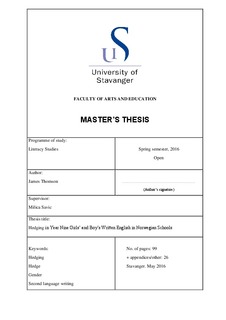| dc.description.abstract | This aim of this thesis is to investigate the use of hedging devices in the English writing of year nine girls and boys in two Norwegian lower secondary schools. Hyland (2005: 52) defines hedges as devices that “indicate the writer’s decision to recognize alternative voices and viewpoints and so withhold complete commitment to a proposition”. These linguistic devices have been shown to be important to academic writing (e.g. Hyland and Milton, 1997). Hyland (1996) argues that hedges should be explicitly taught to language learners at an early stage of their learning process. This research focuses on how hedging devices in language learner writing interact with holistic grades, topic, formality and gender at the lower secondary educational level.
This thesis used mixed methods (Dornyei, 2007) in that it incorporated both quantitative and qualitative data, where the quantitative data was given priority at all stages of data collection and analysis. It consisted of 82 texts written as part of year nine English evaluations from two Norwegian schools. Hedges in this textual data were quantified in terms of hedging category and accuracy. Five categories of hedge were used for this analysis, including Adaptors, Rounders, Plausibility Shields, Explicit Markers of Author Involvement and Verbal Fillers (Holmes, 1986; Prince et al., 1980; Salager-Meyer, 1994). Hedges were counted as either accurate or inaccurate based on conventions of grammaticality, well-formedness and appropriateness (Fetzer, 2004). The frequency per one hundred words of each accurately and inaccurately used hedging category was calculated and used to compare how hedging use interacted with holistic grades, topic, formality and gender. The qualitative data included interviews with three teachers who allowed the researcher to use data from their English classes. The interview data was collected to provide information about the context in which the textual data was written.
The results of this study show that gender is generally not a significant factor in hedging use in pupil writing at this level. Instead, there was greater individual variation in hedging use among each gender group. In terms of holistic grades, hedging was significantly more accurate in texts that received the highest passing grade and less accurate in texts that received the lowest passing grade. The frequencies of each category of accurately and inaccurately used hedge tended to be homogeneous across the mid-range grades. The topic chosen by the school seemed to be a significant factor determining hedging use. The pupils who wrote about sports used more hedges than pupils who wrote literary analyses. This implies that pupils have more personal experience and opinions regarding sports and recognise the need for hedging their statements in texts about this topic. Formality also affected hedging use, where texts written in an informal style contained a significantly higher frequency of accurate hedging devices than texts written in a formal style. This suggests that year nine pupils are more capable at using hedging devices in informal written contexts.
Overall, the data showed that year nine pupils in Norwegian schools have a good understanding of hedging devices, but more explicit tuition may be beneficial to guide pupils in using hedges (“can”, in particular) accurately, in using a wider variety of hedging devices and in recognising when hedges are appropriate to the written formality. Further research could compare language learners’ with native speakers’ hedging use in order to provide insight into what to expect of learners at this level. | nb_NO |

